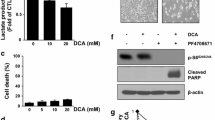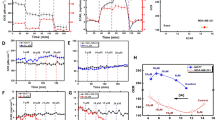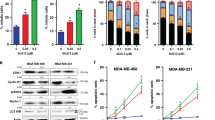Abstract
Targeting glycolysis for cancer treatment has been investigated as a therapeutic method but has not offered a feasible chemotherapeutic strategy. Our aim was to examine whether AMP-activated protein kinase (AMPK), a conditional oncogene, rescues the energetic stress and cytotoxicity induced by 2-deoxyglucose (2-DG), a glycolytic inhibitor, and the related mechanisms. Luciferin/luciferase adenosine triphosphate (ATP) determination, Western analysis, qRT-PCR analyses, MTT growth assay, clonogenic assay, and statistical analysis were performed in this study. 2-DG decreased ATP levels and subsequently activated AMPK, which contribute to intracellular ATP recovery in MCF-7 cells thus exhibiting no apparent cytotoxicity. Compound C, an AMPK inhibitor, further potentiates 2-DG-induced decrease in ATP levels and inhibits their recovery. 2-DG, via AMPK activation, stimulated cAMP response element-binding protein (CREB) phosphorylation and activity and promoted nuclear peroxisome proliferator-activated receptor gamma coactivator-1-beta (PGC-1β) and estrogen-related receptor α (ERRα) protein expression, leading to augmented mitochondrial biogenesis and expression of fatty acid oxidation (FAO) genes including PPARα, MCAD, CPT1C, and ACO. This metabolic adaptation elicited by AMPK counteracts the ATP-depleting and cancer cell-killing effect of 2-DG. However, 2-DG in combination with AMPK antagonists or small interfering RNA caused a dramatic increase in cytotoxicity in MCF-7 but not in MCF-10A cells. Similarly, when combined with inhibition of CREB/PGC-1β/ERRα pathway, 2-DG saliently suppressed mitochondrial biogenesis and the expression of FAO genes, depleted ATP production, and enhanced cytotoxicity in cancer cells. Collectively, the combination of 2-DG and AMPK inhibition synergistically enhanced the cytotoxic potential in breast cancer cells with a relative nontoxicity to normal cells and may offer a promising, safe, and effective breast cancer therapeutic strategy.






Similar content being viewed by others
References
Ershler WB (2006) Capecitabine monotherapy: safe and effective treatment for metastatic breast cancer. Oncologist 11:325–335
National Comprehensive Cancer Network. Clinical practice guidelines in oncology: breast cancer, version 1. http://www.nccn.org/professionals/physician_gls/PDF/breast.pdf. Accessed 23 March 2006
Geschwind JF, Georgiades CS, Ko YH, Pedersen PL (2004) Recently elucidated energy catabolism pathways provide opportunities for novel treatments in hepatocellular carcinoma. Expert Rev Anticancer Ther 4:449–457
Hanahan D, Weinberg RA (2011) Hallmarks of cancer: the next generation. Cell 144:646–674
Pelicano H, Martin DS, Xu RH, Huang P (2006) Glycolysis inhibition for anticancer treatment. Oncogene 25:4633–4646
Maschek G, Savaraj N, Priebe W, Braunschweiger P, Hamilton K, Tidmarsh GF, De Young LR, Lampidis TJ (2004) 2-Deoxy-d-glucose increases the efficacy of adriamycin and paclitaxel in human osteosarcoma and non-small cell lung cancers in vivo. Cancer Res 64:31–34
Zhong D, Xiong L, Liu T, Liu X, Liu X, Chen J, Sun SY, Khuri FR, Zong Y, Zhou Q, Zhou W (2009) The glycolytic inhibitor 2-deoxyglucose activates multiple prosurvival pathways through IGF1R. J Biol Chem 284:23225–23233
Maher JC, Wangpaichitr M, Savaraj N, Kurtoglu M, Lampidis TJ (2007) Hypoxia-inducible factor-1 confers resistance to the glycolytic inhibitor 2-deoxy-d-glucose. Mol Cancer Ther 6:732–741
Jones RG, Thompson CB (2009) Tumor suppressors and cell metabolism: a recipe for cancer growth. Genes Dev 23:537–548
Wu Y, Zhou H, Wu K, Lee S, Li R, Liu X (2014) PTEN phosphorylation and nuclear export mediate free fatty acid-induced oxidative stress. Antioxid Redox Signal 20:1382–1395
Hardie DG (2011) AMP-activated protein kinase: an energy sensor that regulates all aspects of cell function. Genes Dev 25:1895–1908
Shaw RJ, Kosmatka M, Bardeesy N, Hurley RL, Witters LA, DePinho RA, Cantley LC (2004) The tumor suppressor LKB1 kinase directly activates AMP-activated kinase and regulates apoptosis in response to energy stress. Proc Natl Acad Sci USA 101:3329–3335
Weber G (1977) Enzymology of cancer cells (first of two parts). N Engl J Med 296:486–492
Xu RH, Pelicano H, Zhou Y, Carew JS, Feng L, Bhalla KN, Keating MJ, Huang P (2005) Inhibition of glycolysis in cancer cells: a novel strategy to overcome drug resistance associated with mitochondrial respiratory defect and hypoxia. Cancer Res 65:613–621
Landor SK, Mutvei AP, Mamaeva V, Jin S, Busk M, Borra R, Gronroos TJ, Kronqvist P, Lendahl U, Sahlgren CM (2011) Hypo- and hyperactivated Notch signaling induce a glycolytic switch through distinct mechanisms. Proc Natl Acad Sci USA 108:18814–18819
Robey IF, Lien AD, Welsh SJ, Baggett BK, Gillies RJ (2005) Hypoxia-inducible factor-1alpha and the glycolytic phenotype in tumors. Neoplasia 7:324–330
Rae JM, Creighton CJ, Meck JM, Haddad BR, Johnson MD (2007) MDA-MB-435 cells are derived from M14 melanoma cells—a loss for breast cancer, but a boon for melanoma research. Breast Cancer Res Treat 104:13–19
Herzig S, Hedrick S, Morantte I, Koo SH, Galimi F, Montminy M (2003) CREB controls hepatic lipid metabolism through nuclear hormone receptor PPAR-gamma. Nature 426:190–193
Bernatchez G, Giroux V, Lassalle T, Carpentier AC, Rivard N, Carrier JC (2013) ERRalpha metabolic nuclear receptor controls growth of colon cancer cells. Carcinogenesis 34:2253–2261
Schreiber SN, Emter R, Hock MB, Knutti D, Cardenas J, Podvinec M, Oakeley EJ, Kralli A (2004) The estrogen-related receptor alpha (ERRalpha) functions in PPARgamma coactivator 1alpha (PGC-1alpha)-induced mitochondrial biogenesis. Proc Natl Acad Sci USA 101:6472–6477
Lin J, Tarr PT, Yang R, Rhee J, Puigserver P, Newgard CB, Spiegelman BM (2003) PGC-1beta in the regulation of hepatic glucose and energy metabolism. J Biol Chem 278:30843–30848
Huss JM, Torra IP, Staels B, Giguere V, Kelly DP (2004) Estrogen-related receptor alpha directs peroxisome proliferator-activated receptor alpha signaling in the transcriptional control of energy metabolism in cardiac and skeletal muscle. Mol Cell Biol 24:9079–9091
Vega RB, Huss JM, Kelly DP (2000) The coactivator PGC-1 cooperates with peroxisome proliferator-activated receptor alpha in transcriptional control of nuclear genes encoding mitochondrial fatty acid oxidation enzymes. Mol Cell Biol 20:1868–1876
Wu Z, Puigserver P, Andersson U, Zhang C, Adelmant G, Mootha V, Troy A, Cinti S, Lowell B, Scarpulla RC, Spiegelman BM (1999) Mechanisms controlling mitochondrial biogenesis and respiration through the thermogenic coactivator PGC-1. Cell 98:115–124
Schagger H (2002) Respiratory chain supercomplexes of mitochondria and bacteria. Biochim Biophys Acta 1555:154–159
Jeon SM, Hay N (2012) The dark face of AMPK as an essential tumor promoter. Cell Logist 2:197–202
Dowling RJ, Goodwin PJ, Stambolic V (2011) Understanding the benefit of metformin use in cancer treatment. BMC Med 9:33
Shackelford DB, Abt E, Gerken L, Vasquez DS, Seki A, Leblanc M, Wei L, Fishbein MC, Czernin J, Mischel PS, Shaw RJ (2013) LKB1 inactivation dictates therapeutic response of non-small cell lung cancer to the metabolism drug phenformin. Cancer Cell 23:143–158
Liang J, Mills GB (2013) AMPK: a contextual oncogene or tumor suppressor? Cancer Res 73:2929–2935
Kato K, Ogura T, Kishimoto A, Minegishi Y, Nakajima N, Miyazaki M, Esumi H (2002) Critical roles of AMP-activated protein kinase in constitutive tolerance of cancer cells to nutrient deprivation and tumor formation. Oncogene 21:6082–6090
Philp A, Belew MY, Evans A, Pham D, Sivia I, Chen A, Schenk S, Baar K (2011) The PGC-1alpha-related coactivator promotes mitochondrial and myogenic adaptations in C2C12 myotubes. Am J Physiol Regul Integr Comp Physiol 301:R864–R872
Lin J, Puigserver P, Donovan J, Tarr P, Spiegelman BM (2002) Peroxisome proliferator-activated receptor gamma coactivator 1beta (PGC-1beta), a novel PGC-1-related transcription coactivator associated with host cell factor. J Biol Chem 277:1645–1648
Zhang H, Gao P, Fukuda R, Kumar G, Krishnamachary B, Zeller KI, Dang CV, Semenza GL (2007) HIF-1 inhibits mitochondrial biogenesis and cellular respiration in VHL-deficient renal cell carcinoma by repression of C-MYC activity. Cancer Cell 11:407–420
Suzuki T, Miki Y, Moriya T, Shimada N, Ishida T, Hirakawa H, Ohuchi N, Sasano H (2004) Estrogen-related receptor alpha in human breast carcinoma as a potent prognostic factor. Cancer Res 64:4670–4676
Pelicano H, Zhang W, Liu J, Hammoudi N, Dai J, Xu RH, Pusztai L, Huang P (2014) Mitochondrial dysfunction in some triple-negative breast cancer cell lines: role of mTOR pathway and therapeutic potential. Breast Cancer Res 16:434
Cheng G, Zielonka J, Dranka BP, McAllister D, Mackinnon AC Jr, Joseph J, Kalyanaraman B (2012) Mitochondria-targeted drugs synergize with 2-deoxyglucose to trigger breast cancer cell death. Cancer Res 72:2634–2644
Maher JC, Savaraj N, Priebe W, Liu H, Lampidis TJ (2005) Differential sensitivity to 2-deoxy-d-glucose between two pancreatic cell lines correlates with GLUT-1 expression. Pancreas 30:e34–e39
Acknowledgments
This work was supported by the National Institutes of Health (NIH, NCI, NIMHD, NCATS) Grants: U54 CA143931-01, U54MD007598, UL1TR000124 (J. V. Vadgama).
Conflict of interest
All authors declare no conflict of interest.
Author information
Authors and Affiliations
Corresponding author
Electronic supplementary material
Below is the link to the electronic supplementary material.
Rights and permissions
About this article
Cite this article
Wu, Y., Sarkissyan, M., Mcghee, E. et al. Combined inhibition of glycolysis and AMPK induces synergistic breast cancer cell killing. Breast Cancer Res Treat 151, 529–539 (2015). https://doi.org/10.1007/s10549-015-3386-3
Received:
Accepted:
Published:
Issue Date:
DOI: https://doi.org/10.1007/s10549-015-3386-3




